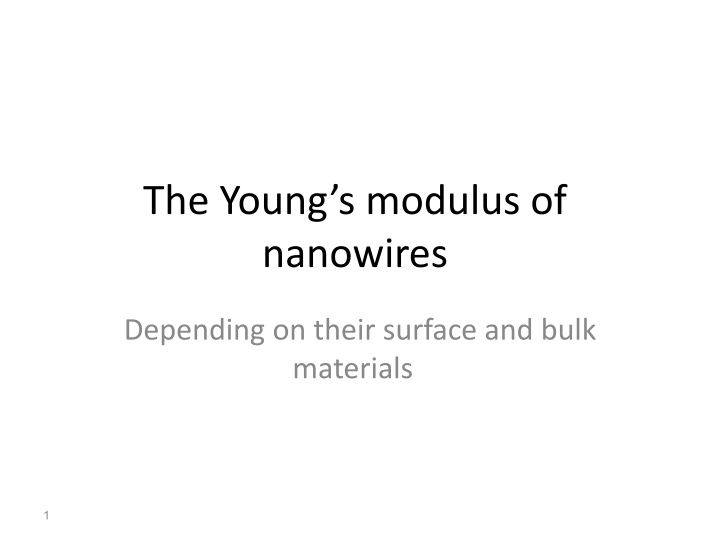
The Size Dependence of Nanomaterials' Elastic Properties
Discover how the Young's modulus of nanomaterials is influenced by size and surface properties, impacting the design of electromechanical devices at the nano scale. Explore the intricate relationship between surface stress, bulk materials, and mechanical performance of 1D nanowires.
Download Presentation

Please find below an Image/Link to download the presentation.
The content on the website is provided AS IS for your information and personal use only. It may not be sold, licensed, or shared on other websites without obtaining consent from the author. If you encounter any issues during the download, it is possible that the publisher has removed the file from their server.
You are allowed to download the files provided on this website for personal or commercial use, subject to the condition that they are used lawfully. All files are the property of their respective owners.
The content on the website is provided AS IS for your information and personal use only. It may not be sold, licensed, or shared on other websites without obtaining consent from the author.
E N D
Presentation Transcript
The Youngs modulus of nanowires Depending on their surface and bulk materials 1
Using the concept of surface stress, we developed a model that is able to predict the Young s modulus of nanowires as a function of nanowire diameters from the calculated properties of their surface and bulk materials. We took both equilibrium strain effect and surface stress effect into consideration to account for the geometric size influence on the elastic properties of nanowires. We combined first-principles density functional theory calculations of material properties with linear elasticity theory of clamped-end three-point bending. 2
Currently, many powerful electromechanical devices can be designed and fabricated at the micro level such as microelectromechanical systems (MEMS). It is a highly active research forefront to develop future electromechanical devices with size in the nano scale, for instance, nanoelectromechanical systems (NEMS). For example, a nano generator, which uses ZnO nanowires to convert mechanical energy to electrical energy, has been successfully fabicated. NEMS employs one-dimensional (1D) nanomaterials (nanowires, nano belts, and/or nanotubes) as its active components to generate, transmit, and convert powers and motions. Hence, the dependence of the mechanical properties on the geometric size of 1D nanomaterials is a very important factor in affecting the performance of those 1D nanomaterials in the NEMS devices. 3
So far, several different fashions of the size dependence of the elastic properties of nanomaterials have been revealed: (1) Young s modulus increases with the decreasing size, for example, in Ag and Pd nanowires. (2) Young s modulus decreases with the decreasing size, for example, in Cr and Si nano cantilevers. (3) Young s modulus shows little dependence of the size of the nanomaterials such as Au nanowires. Moreover, for a same nanomaterial, different research groups could observe and report the opposite size-dependence of its elastic properties. For the case of 1D ZnO nanomaterials, some measurements indicated that their Young s modulus should be lower than the bulk modulus. 4
The mechanism for how the Youngs modulus of 1D nanomaterials depends on their size and surface . Generally , the surface of the nanomaterials will exert great influence on its overall mechanical properties. The Young s modulus of a 1D nanomaterial is determined by both bulk elastic modulus and surface elastic modulus. The elastic response of a 1D nanomaterial depends strongly on its surface elastic constant . The relative increase or decrease of the elastic properties of nanomaterials may be the results of surface bonding and bulk nonlinear phenomena. Therefore, it is of great interest to quantitatively investigate how to predict the elastic properties of 1D nanomaterials from the properties of the surface and bulk materials. 5
The model mainly focuses on the role of surface stress effect in determining the Young s modulus of 1D nanomaterials. Surface stress is defined as the reversible work per unit area required to elastically stretch a surface . Theoretical study pointed out that a negative (compressive) surface stress is the reason for the observed decrease in Young s modulus with decreasing diameter of the ZnO nanowires. The surface stress effect are also responsible for the reduction in the resonant frequencies of Si nanowires and the yield strength of Al nanowires. 6
The model that predicts the Youngs modulus of the nanowire with a given diameter based on surface stress effect; we give the required properties of bulk and surface materials calculated using first-principles density functional theory (DFT) method and then evaluate the Young s modulus of the nanowires using our developed model. The model predictions are compared with the available experimental data. 7
Modeling The relation between the Young s modulus of a nanowire (with a circular cross-section) and its material properties assuming clamped-end three-point bending loading condition. The total energy of such nanowire is expressed as the sum of the energy contributions from bulk and surface materials. We assumed the external surface of nanowires is a surface layer with a thickness of t. 8
A. Effect of equilibrium strain The equilibrium bulk material has the lowest energy at the zero- strain state of the crystal lattices. However, the lowest-energy configuration of the surface layers does not necessary have the same lattice parameters as the zero-strain state of the bulk materials. This is because the arrangement and separation of atoms are different in the surface andin the bulk crystal. The bulk energy density ( ) and the surface energy ( ) can be written in the following forms. 9
The existence of this equilibrium strain in the nanowires has already been revealed in molecular dynamics . The equilibrium strain would affect the elastic modulus of the core (bulk) region of the nanowires. If a nanowire is deformed by a strain from its equilibrium state (with an equilibrium strain *) under a load, then (note: is the strain with respect to the equilibrium crystal lattice). Hence, the Young s modulus contributed from the nanowire s core should be: 12






















